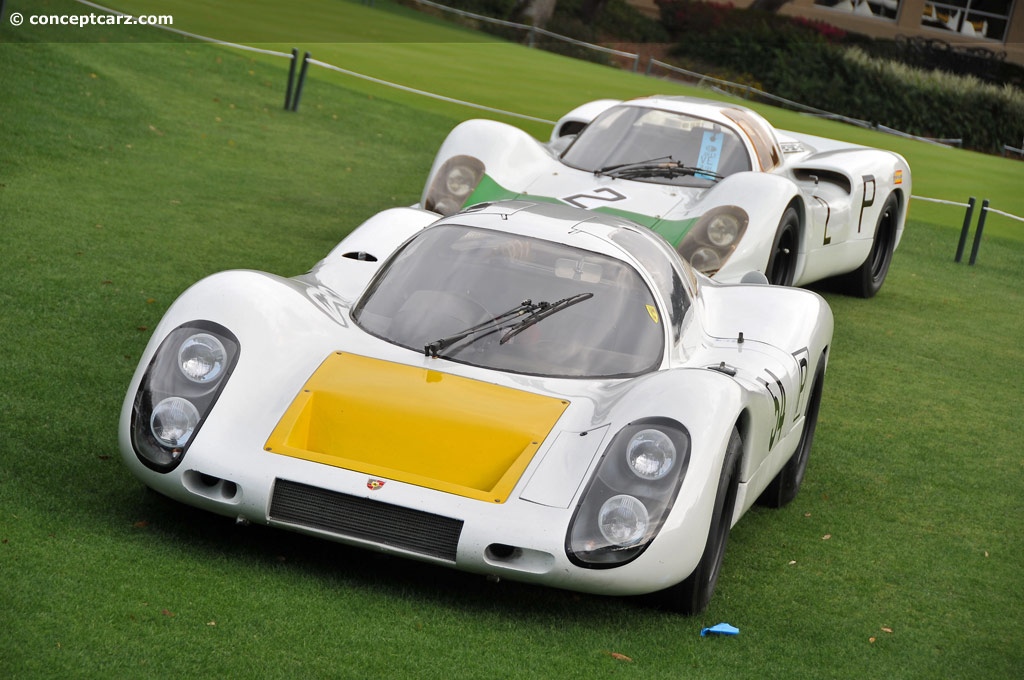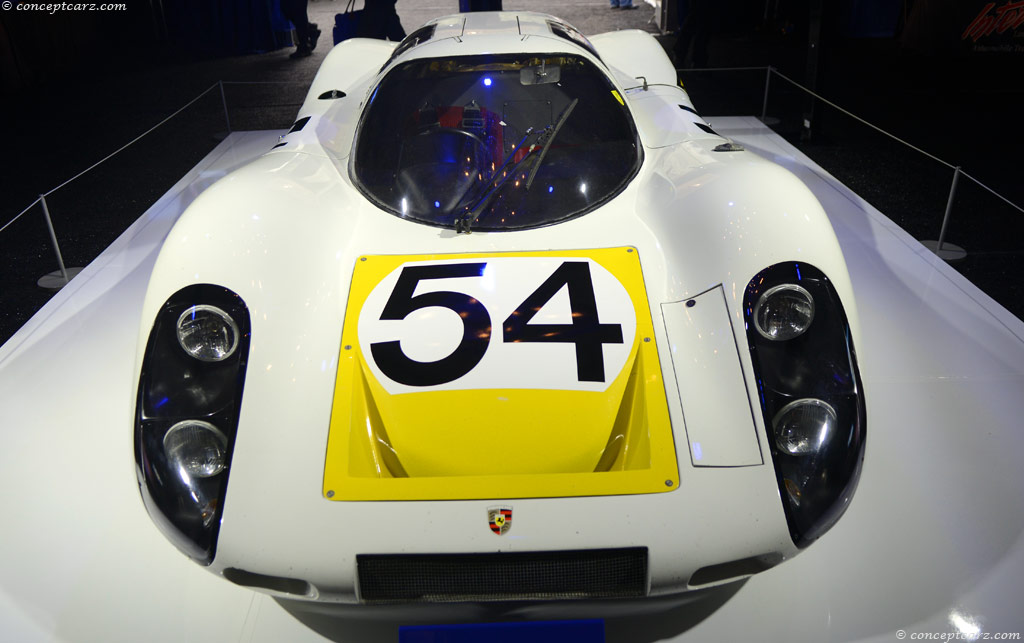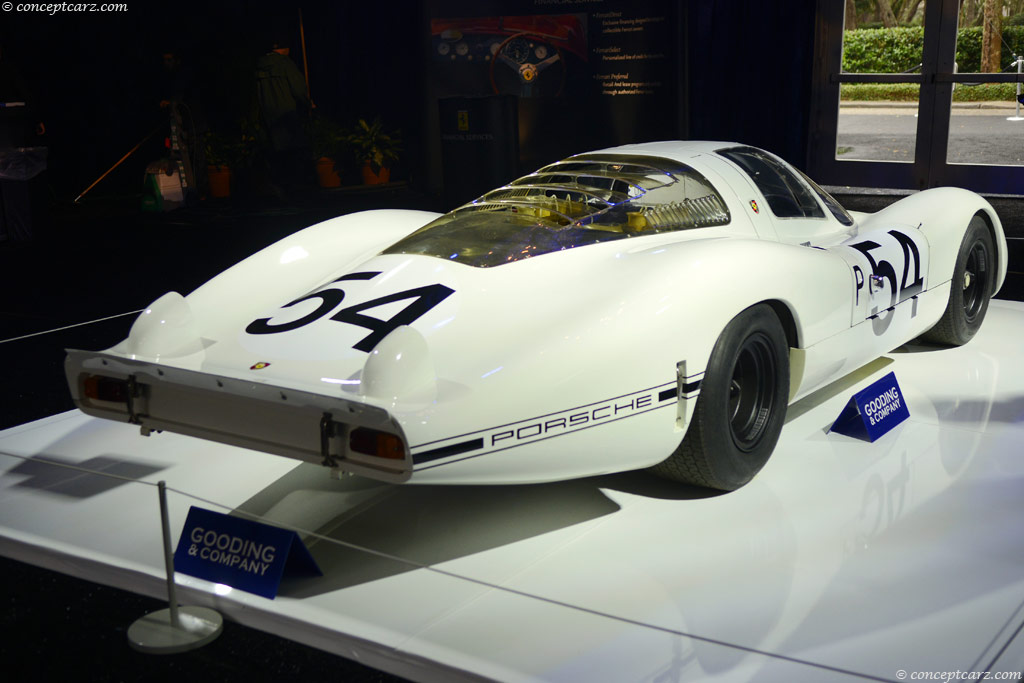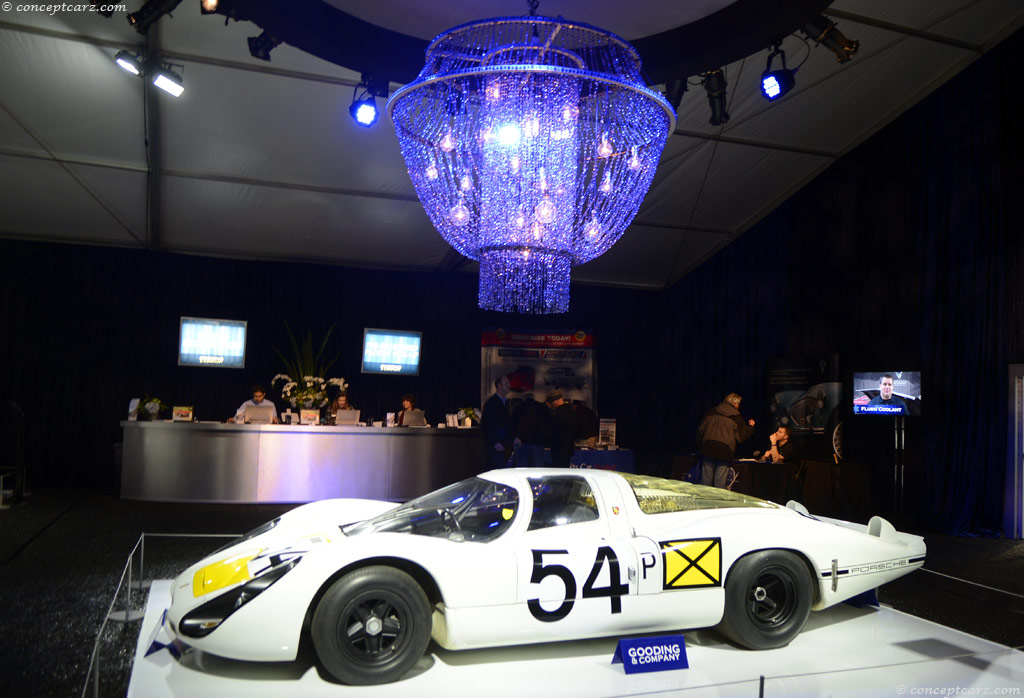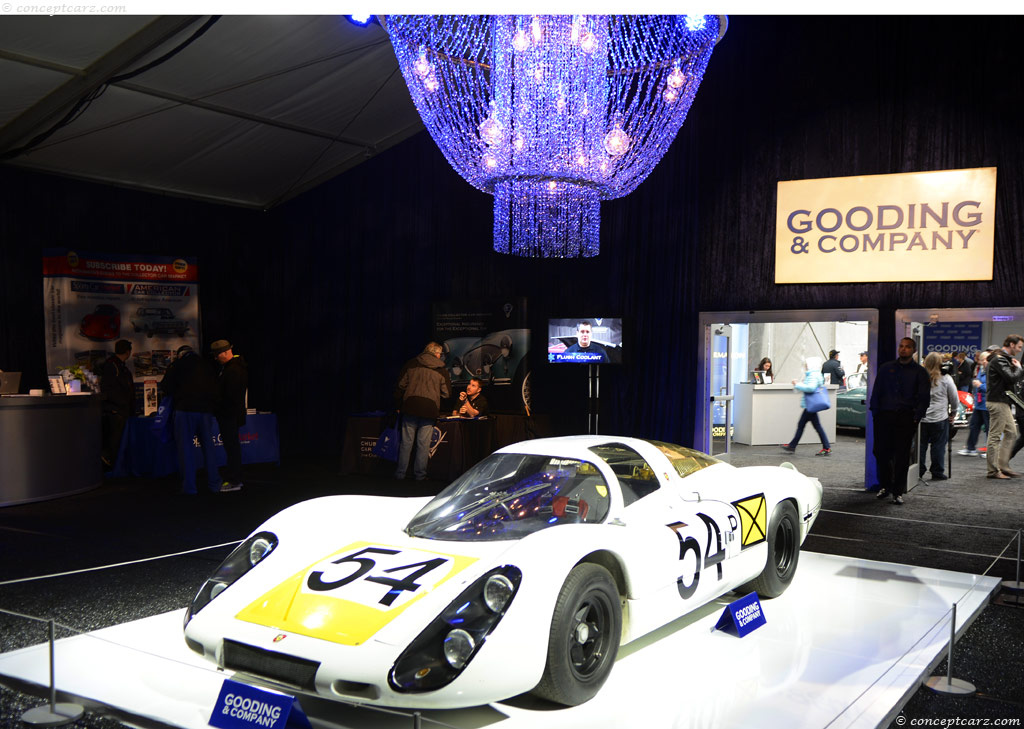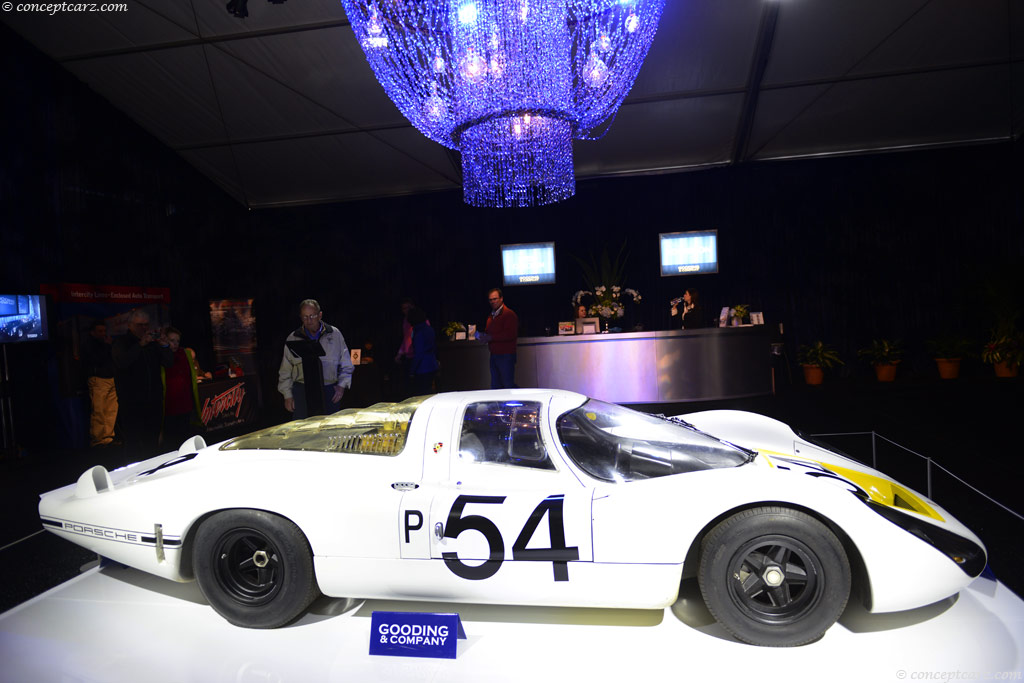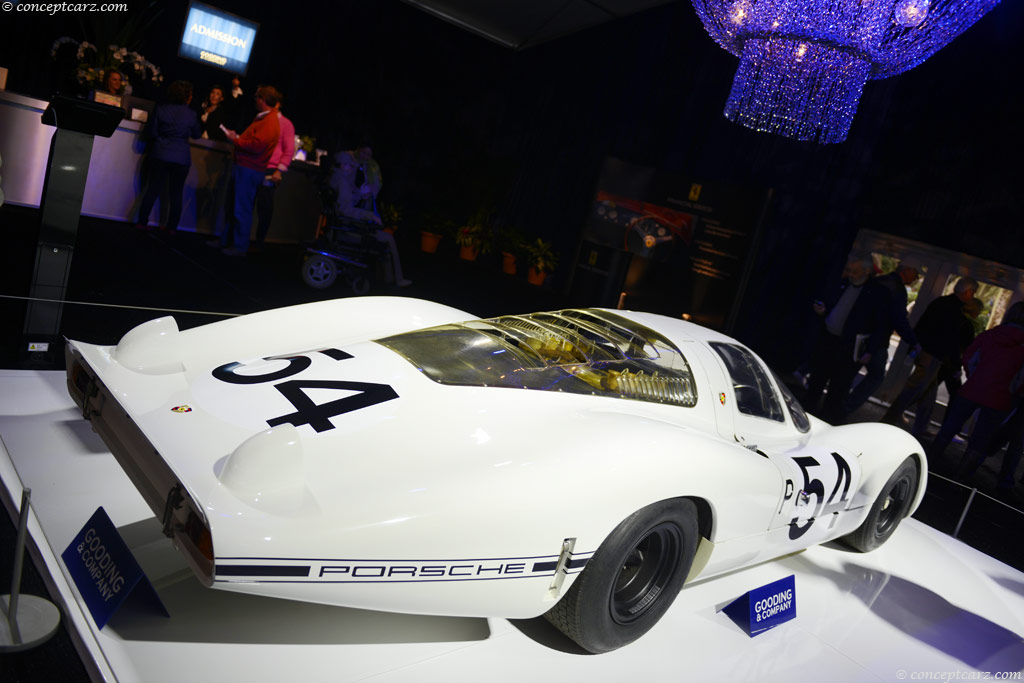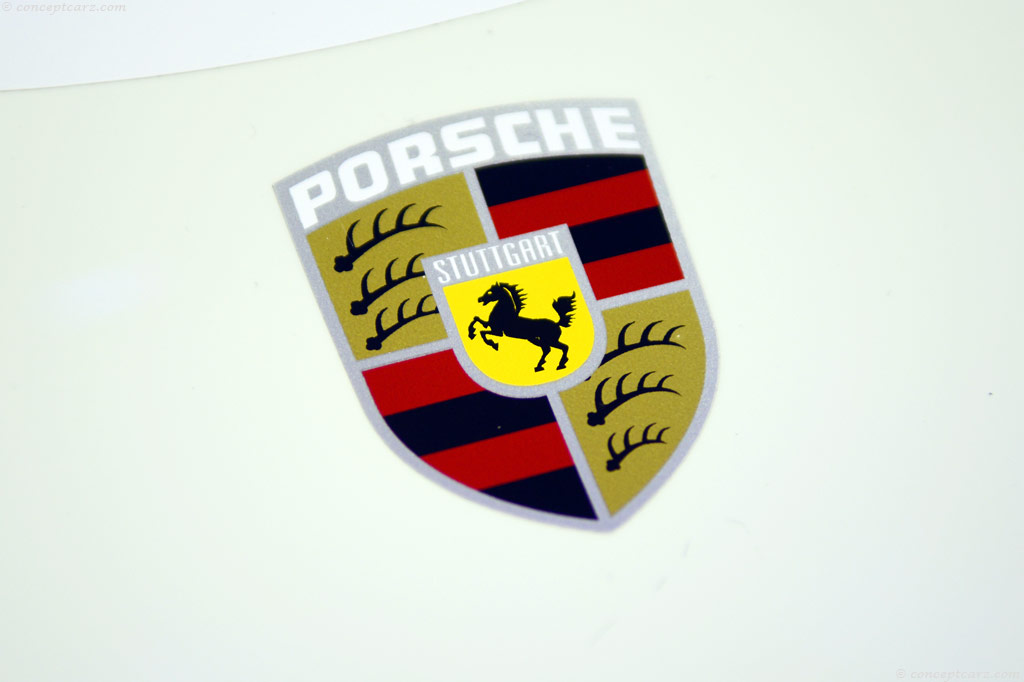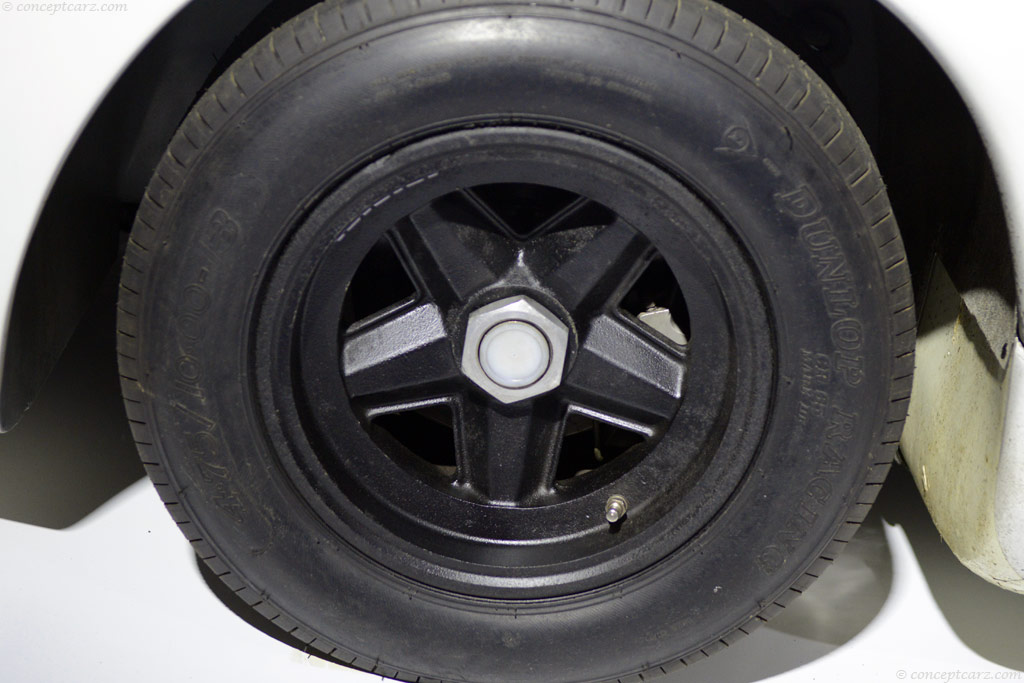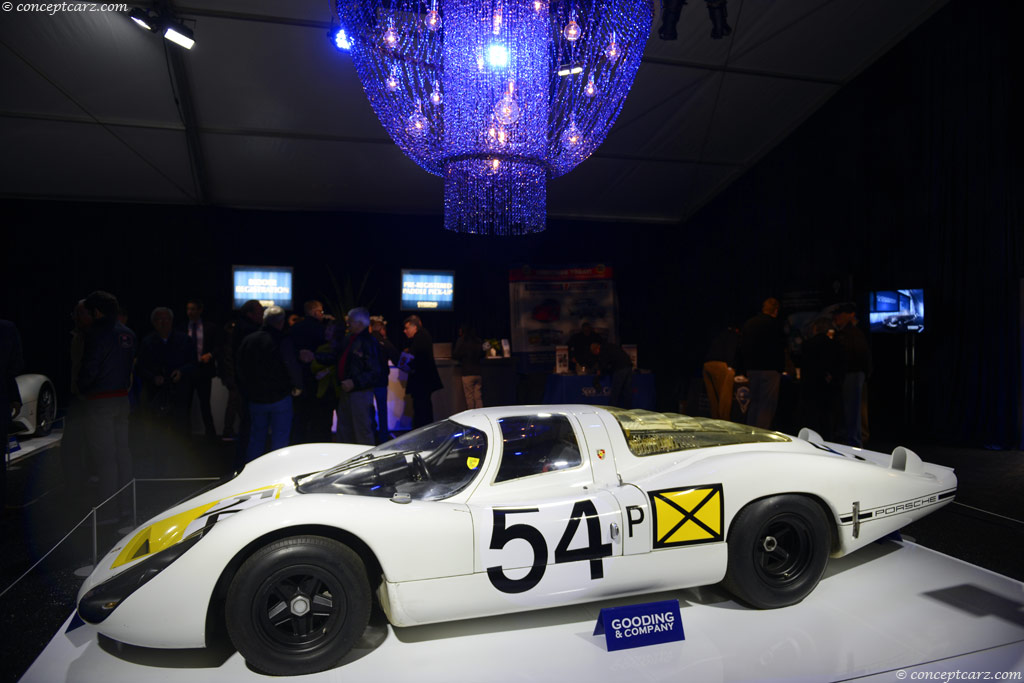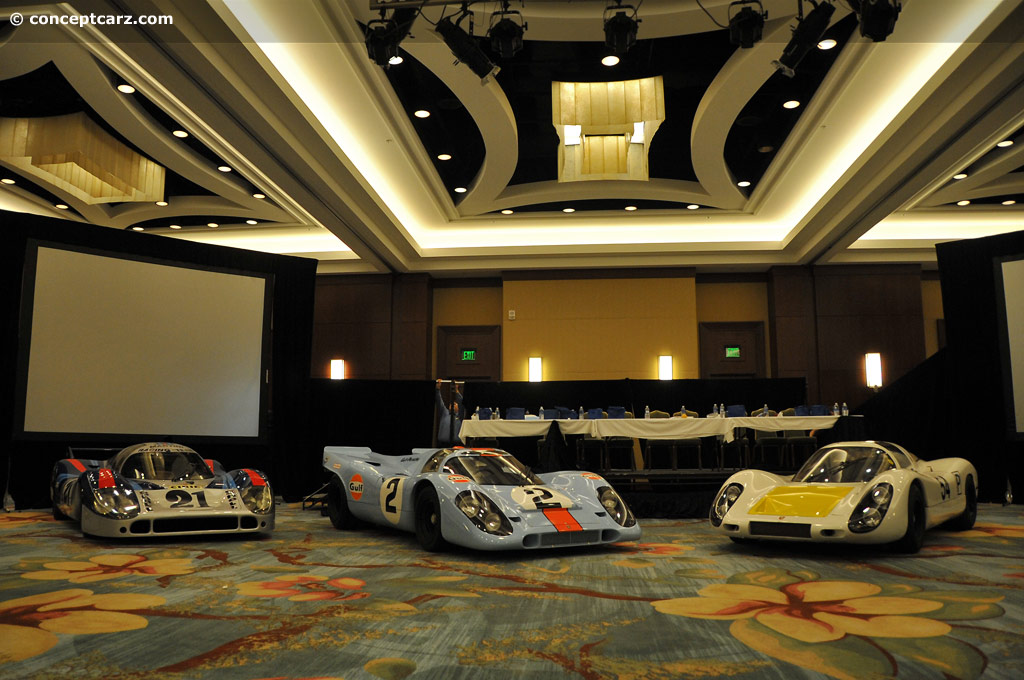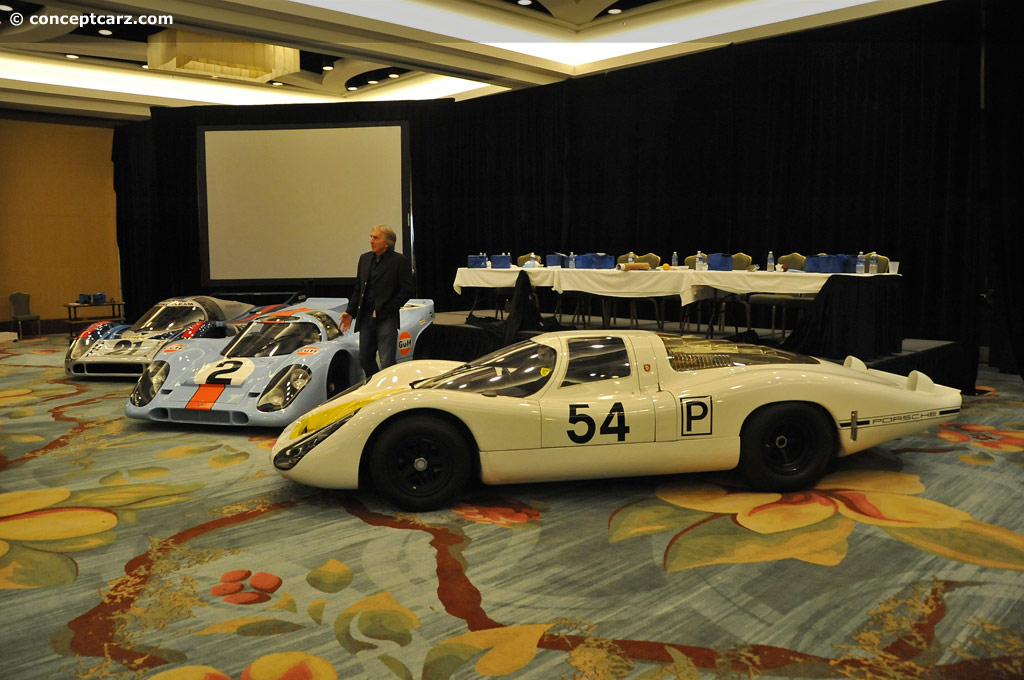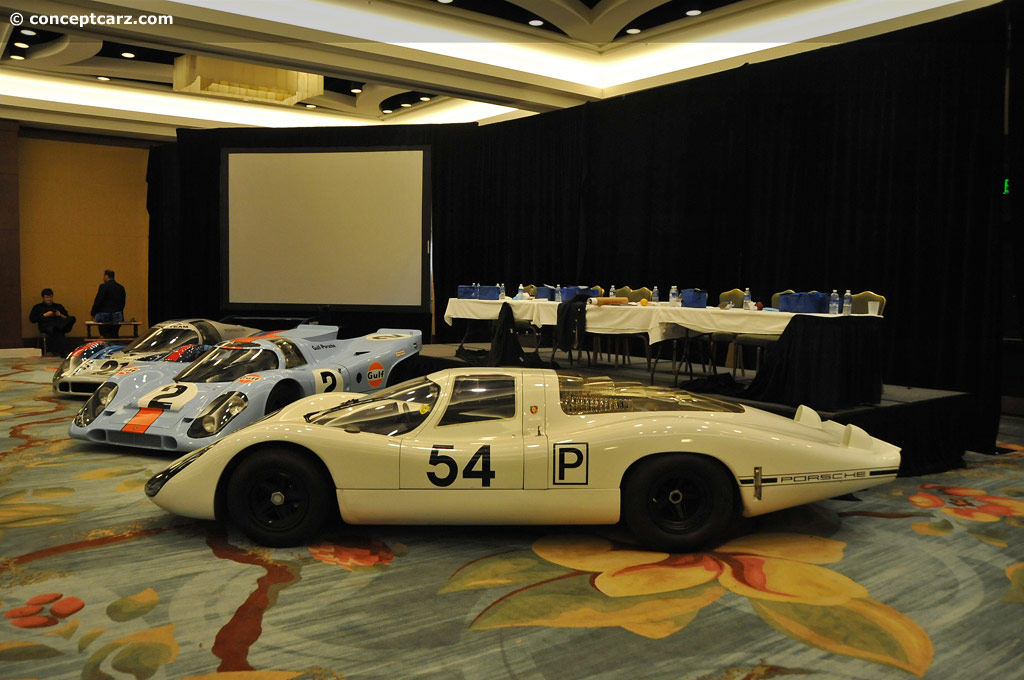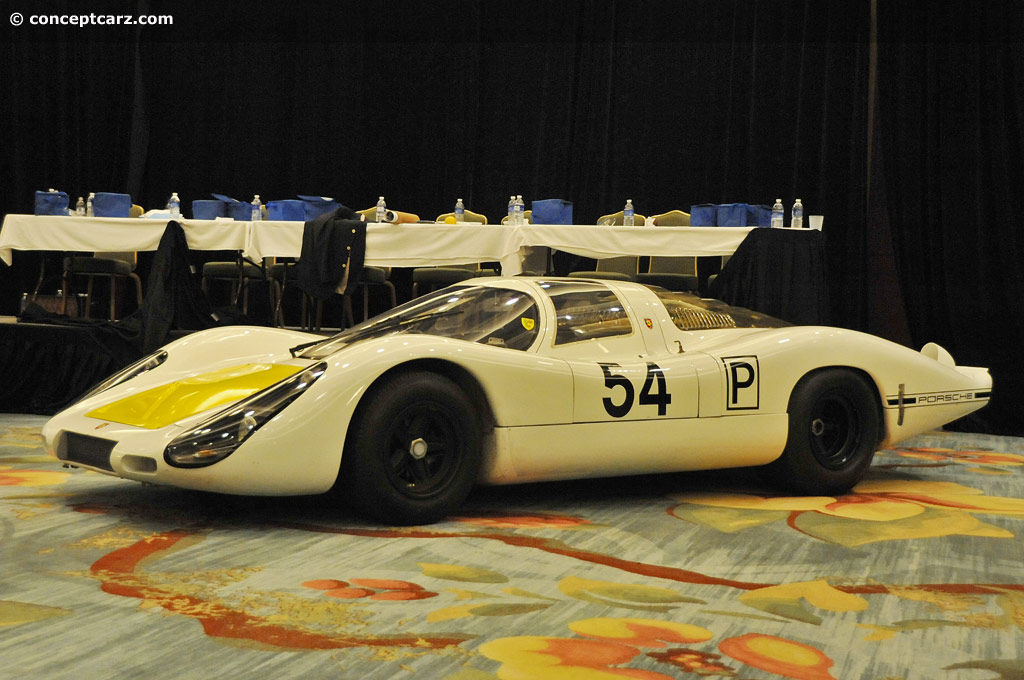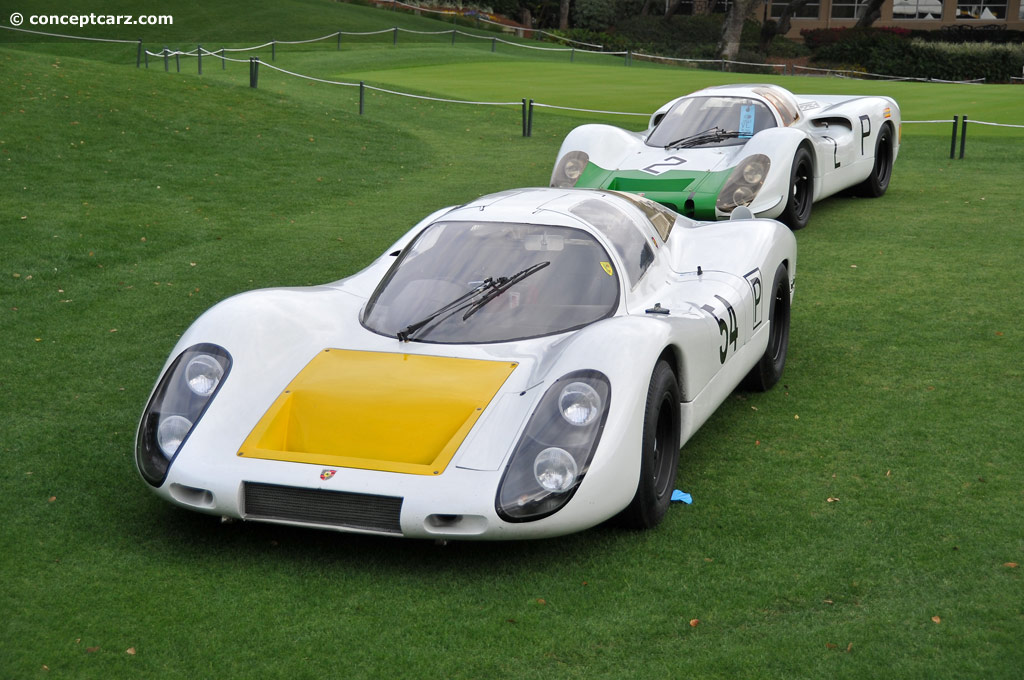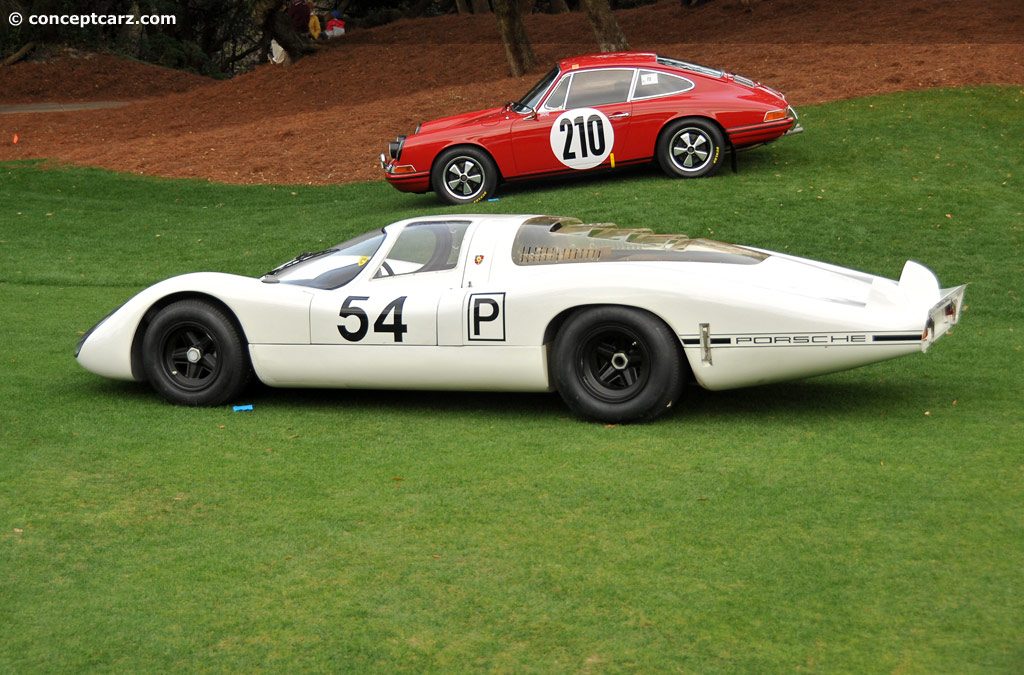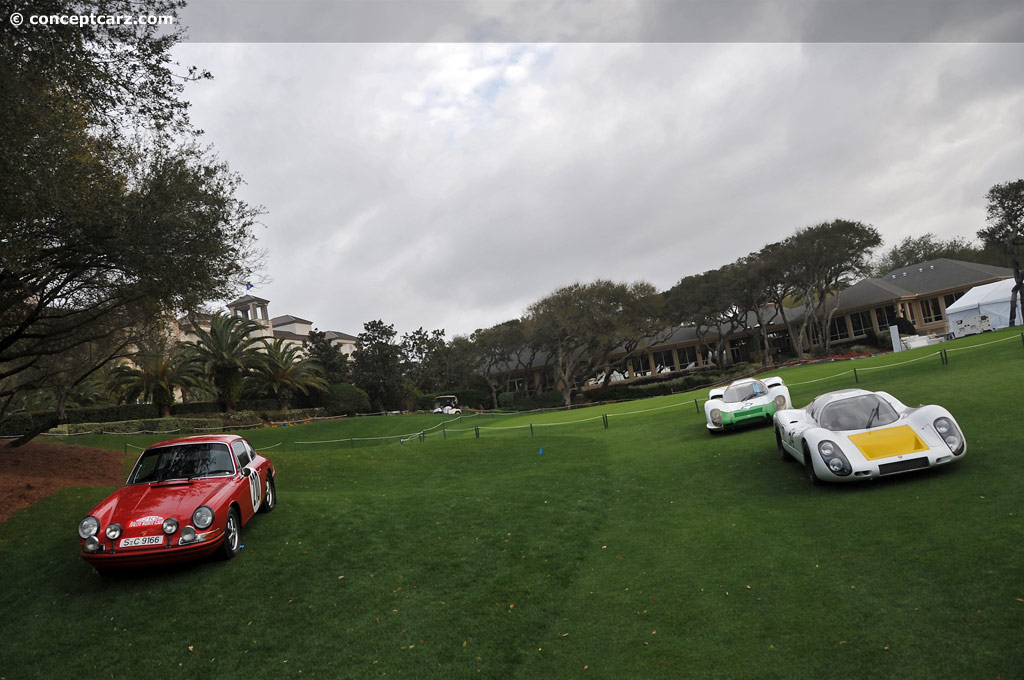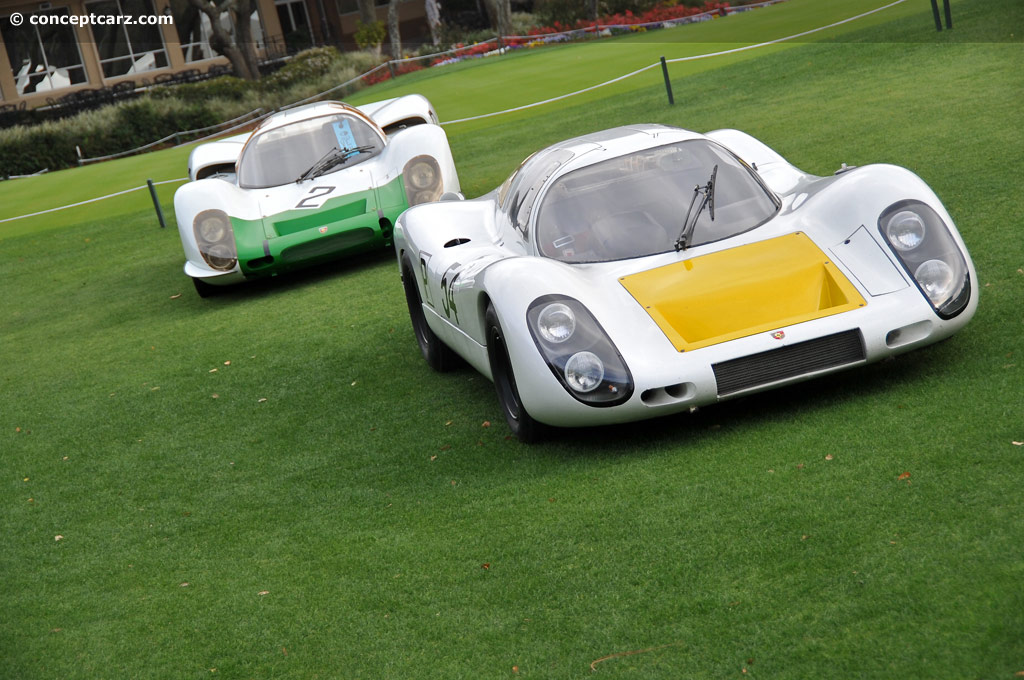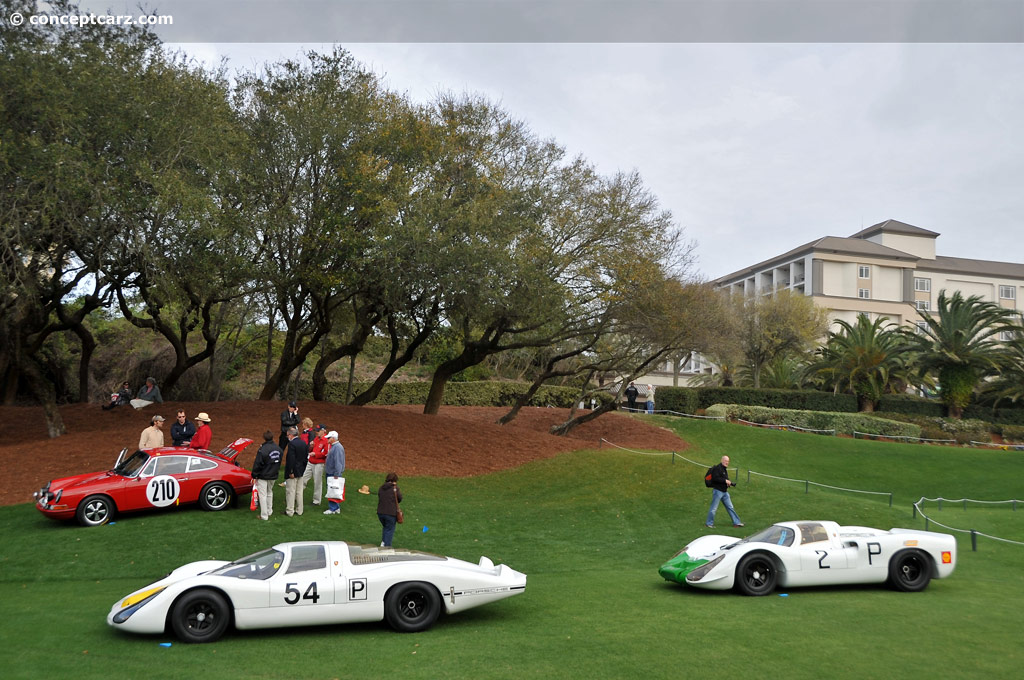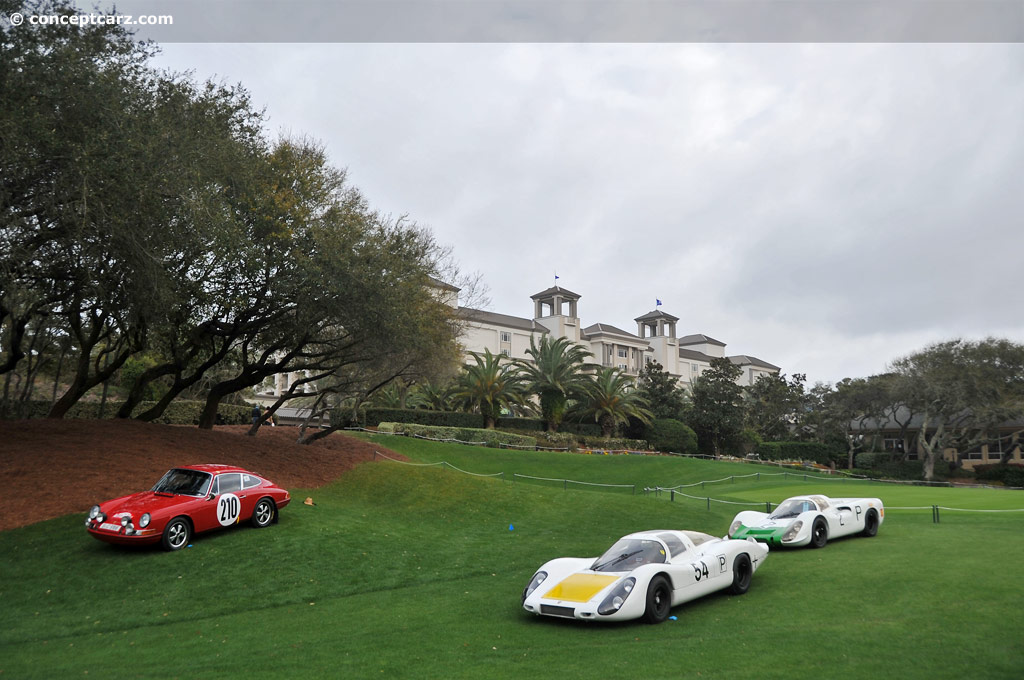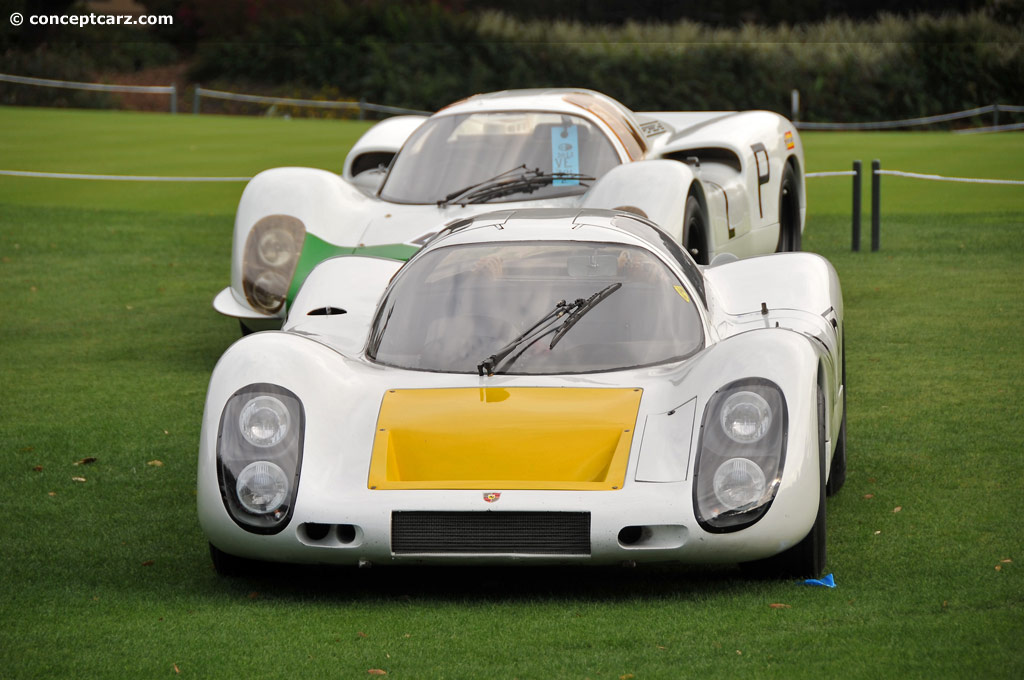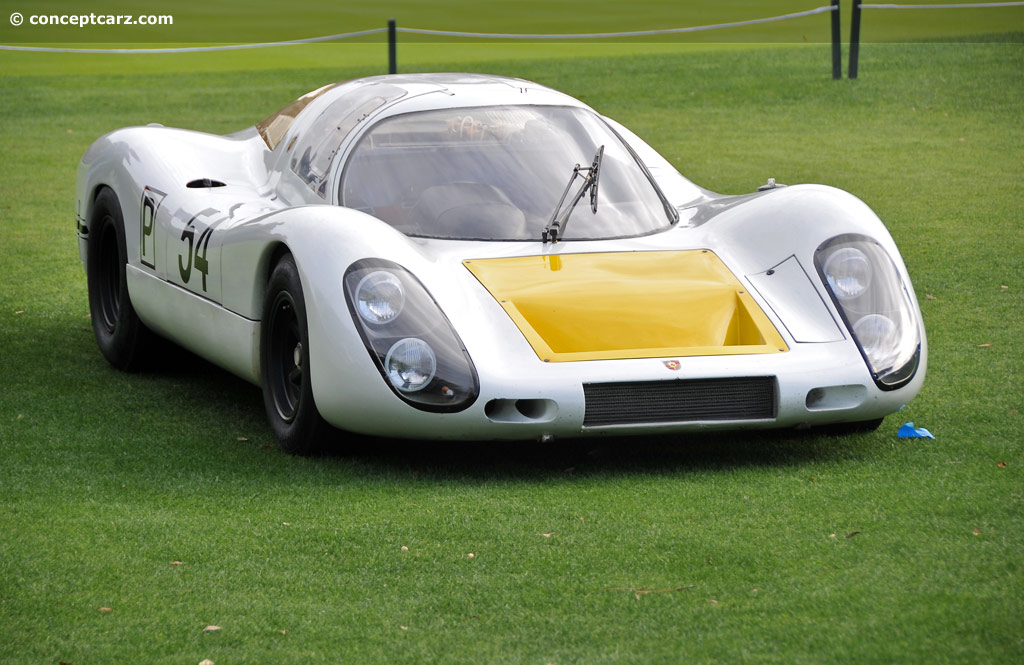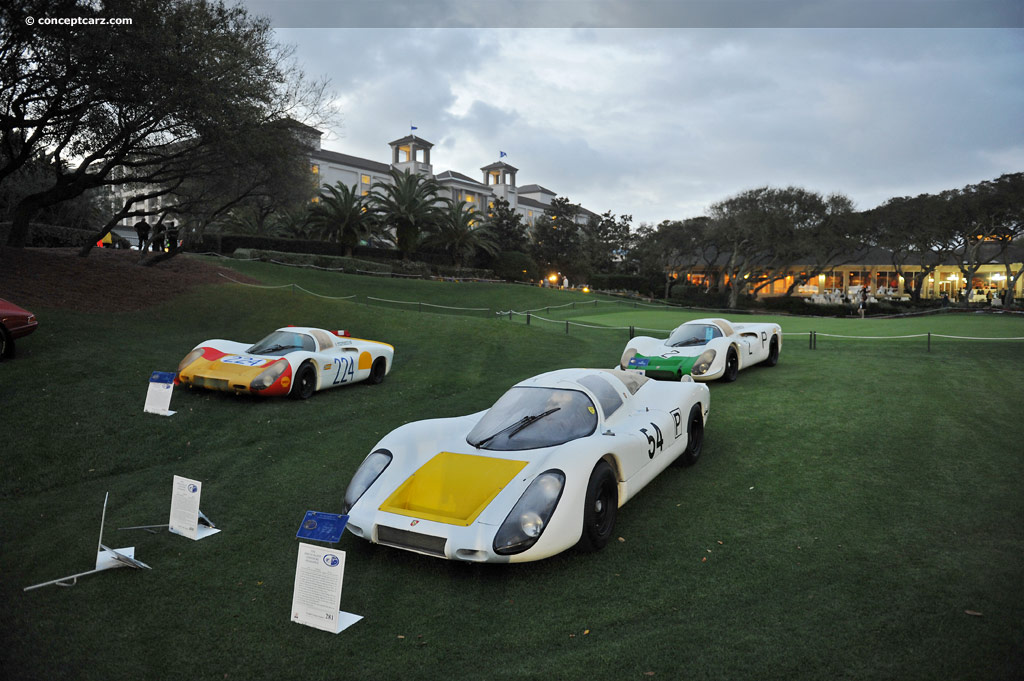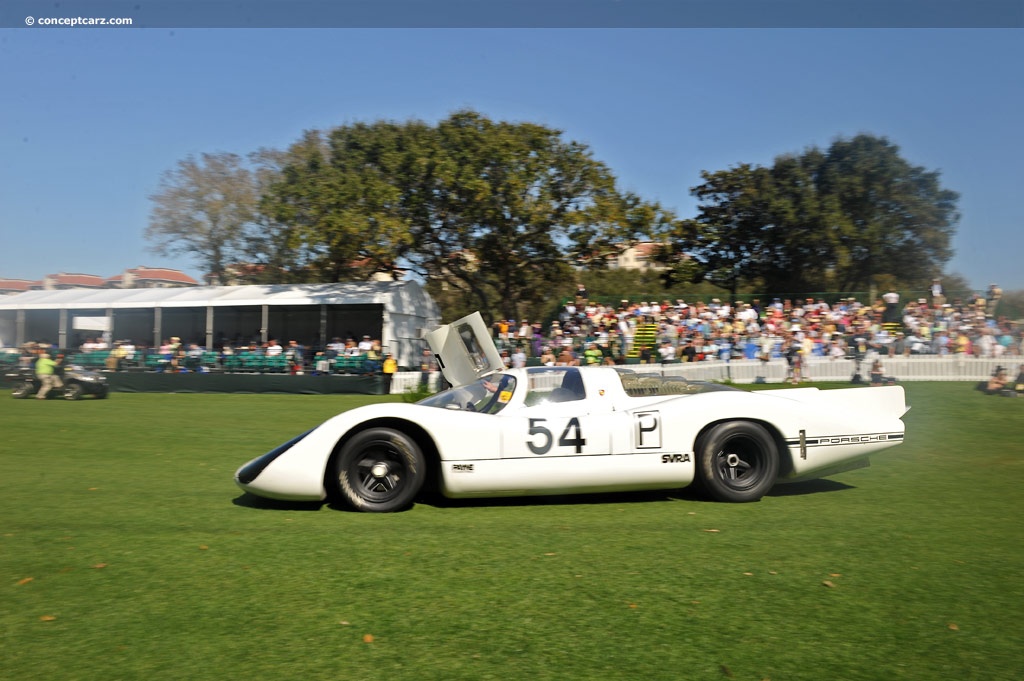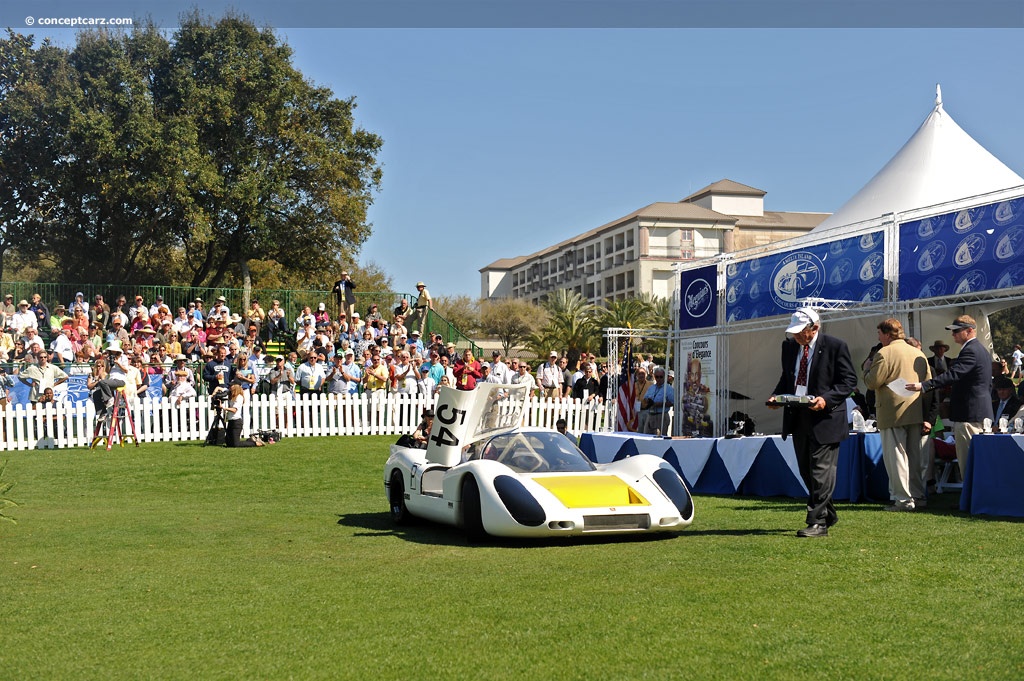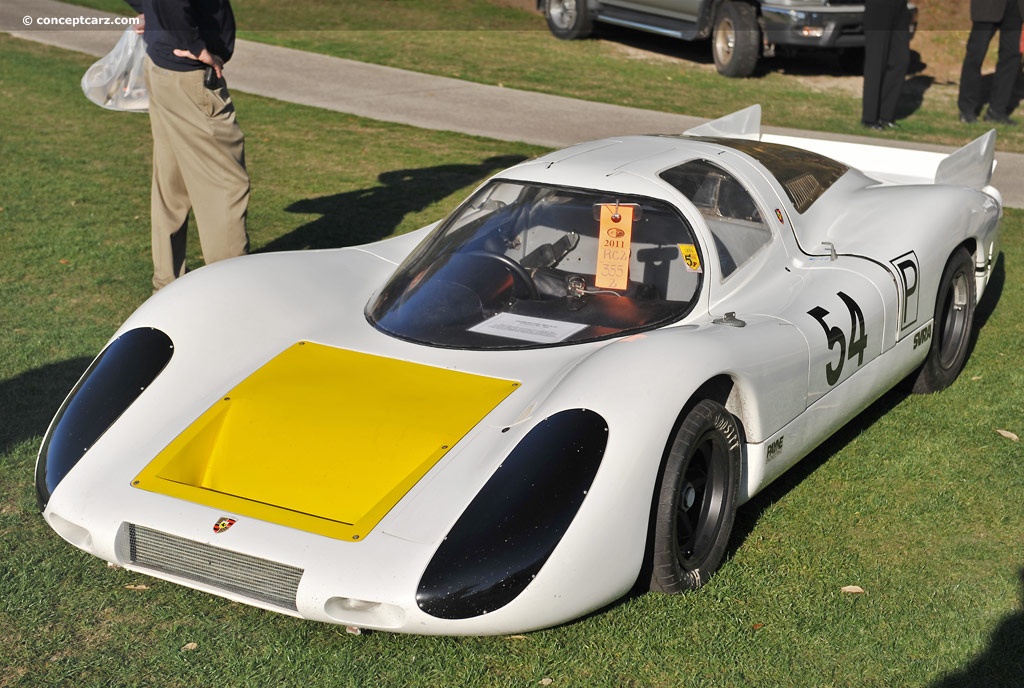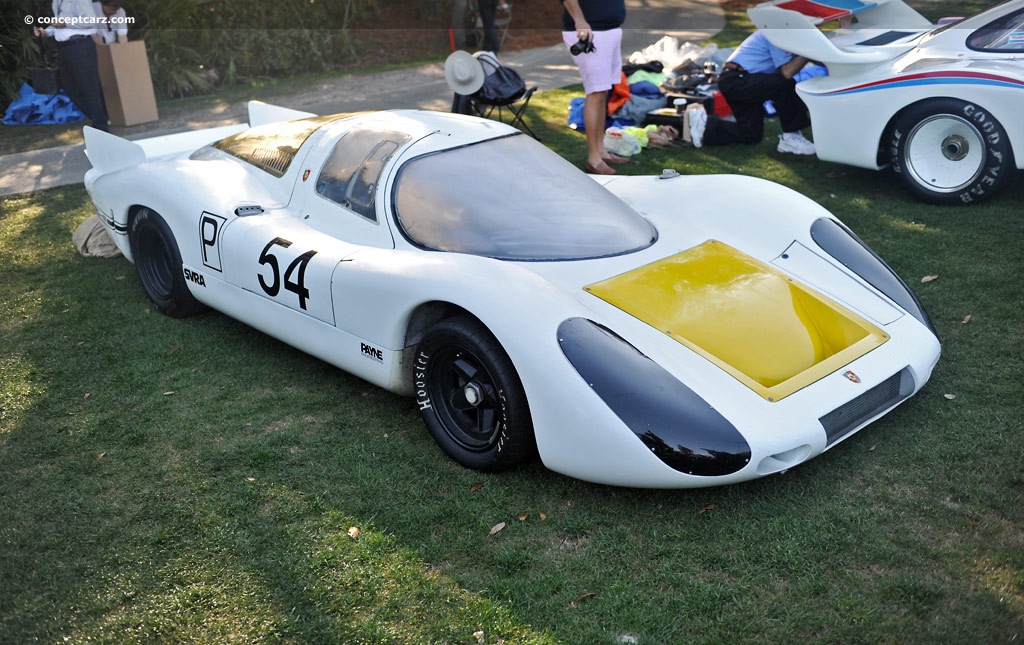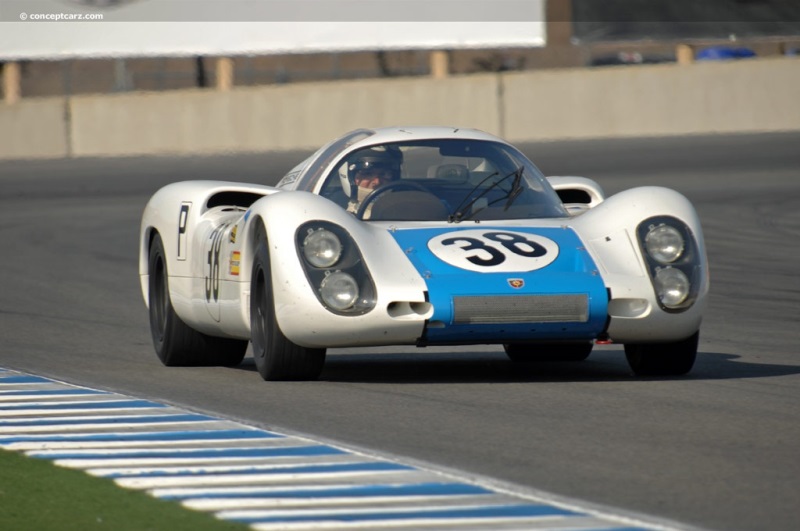Image credit: © conceptcarz.com (Reproduction Or reuse prohibited).
Porsche had long dominated the under two-liter sports car races, but in 1968, with the unveiling of the 907 model, Porsche became a contender for top honors. Powered by a normally aspirated eight-cylinder engine displacing only 2.2-liters, yet producing 270 hp, the 907 won three significant FIA World Championship races in 1968 - the Daytona 24 Hour, the 12 Hours of Sebring and the Targa Florio. Vic Elford was the winning driver in two of those events.
This vehicle, chassis number 005, was the Daytona 24 winner leading a 907 one-two-three sweep of the event, Porsche's first 24 hour race win. This specific car was also 2nd at the Monza 1000 km race in 1968, and was an unprecedented five-time Le Mans 24 race entry, clearly the best history example of the Porsche 907.
A total of eight long tail (LH) 907s were originally built; this is one of only two that remain today.
This vehicle, chassis number 005, was the Daytona 24 winner leading a 907 one-two-three sweep of the event, Porsche's first 24 hour race win. This specific car was also 2nd at the Monza 1000 km race in 1968, and was an unprecedented five-time Le Mans 24 race entry, clearly the best history example of the Porsche 907.
A total of eight long tail (LH) 907s were originally built; this is one of only two that remain today.
Porsche's list of accomplishments in endurance sportscar racing is vast, almost overwhelming at times to ponder. The automaker has been so successful in the category that it becomes rather easy to overlook some of its most precious chassis. However, a mere perusal of the record books and important races in history will cause a handful to come to the fore. Chassis 907-005 is just such an example.
Prior to the 1970s, Ferrari and Jaguar were considered the best in sportscar racing. However, when Porsche finally got on top, they would never leave, and for more than a few decades, it seemed only a Porsche was capable of any kind of success.
Porsche's 907 would make its debut at Le Mans in 1967. However, that debut would come at a time when Ford's GT40s were ruling the Le Mans world, and so, it was easy to overlook the sleek new offering from Stuttgart.
Porsche had earned a very valid reputation for taking underpowered, light and nimble little cars and turning them into machines capable of punching above their weight. They knew, though, that to compete against Ford and Ferrari, they could not make do with less. They would need to start out on somewhat equal footing. This meant beginning work on an eight-cylinder boxer engine. By the time of Le Mans in 1967, power output from the engine had been increased to 270bhp. Unfortunately, the new eight cylinder engine wasn't ready in time to contest a 24 hour race. Therefore, Porsche would be left having to mount smaller six-cylinder engines into the 907. Against the 7.0-liter GT40s the 907 just didn't have the power and performance.
But whatever Porsche lacked in reliability and raw performance, the 907 made up for it with its incredible design. Aided by wind tunnel testing, Porsche would create the 907 to be unlike anything else it had ever produced before, and that would certainly be the case. From its shapely nose, to its aerodynamically-raked cockpit, to its long and smooth tail, the 907 was unlike anything else that would be positioned on the grid for Le Mans in 1967. It well and truly was the future look of prototype racing even before there really was such a thing.
Porsche had confidence that when its eight-cylinder engine was truly ready to race that it would take its place among the best in the world. When the engine was finally ready Porsche needed to find the right moment to test its abilities. The best opportunity would come in early 1968.
The big 7.0-liter engines had done themselves in. New regulations would limit engine size to 3.0-liters. Porsche's new eight-cylinder engine wasn't far from that goal so they would set about creating a new engine that would conform to the new regulations. Ferrari would protest by not even competing.
The first opportunity to race in a long-distance affair under the new regulations would come on the 3rd and 4th of February with the 24 Hours of Daytona. Though the weather conditions would be cold, the competition was going to be hot with the Porsches going up against Ford GT40s, Alfa Romeo and Lancia.
Two GT40s would start from the front row after Jacky Ickx took the pole in the number 8, J.W. Automotive entry, GT40. Porsche would enter four examples of the 907 longtails. Positions 3rd through 6th on the grid would all be occupied by the 907s. It was clear the new eight-cylinder engine was capable of competing, even with the bigger engines powering the Fords.
It wouldn't look that good at the start of the race as the GT40s would power their way into the lead. The Porsche 907s would keep things interesting as the number 53 Porsche 907 would suffer a puncture. The result of the damage from the tire would lead to the car being retired after just 104 laps.
The good news would be the fact the fastest GT40, that driven by Ickx and Brian Redman, would already be out of the race as a result of gearbox failure. This would be followed up by the number 9 GT40 dropping out after 430 laps as a result of a leaking fuel tank. The Porsches would suffer no such trouble, and, with time closing, would find themselves in the first three positions overall. Leading then all would be chassis 005 driven by Elford, Neerpasch, Stommelen, Siffert and Herrmann. Assembled in line-abreast formation, the three longtails would come across the line pronouncing Porsche's rise to dominance. As stated by Kim Chapin in a February 1968 issue of Sports Illustrated, 'The one positive result of the race is that Porsche—long overshadowed by the bigger cars despite its excellence and its consistency in winning prizes for medium-sized engines—is now the endurance star and may remain so all season long.' How true this would be, except the dominance wouldn't just last the season, but for decades to come.
Following the incredible victory at Daytona, 005 would go on to score a 2nd place result in the 1000 Kilometers of Monza. At the time, Porsche was already developing the follow-up to the 907, the 908, therefore, the action at the 1968 24 Hours of Le Mans would be palpable. Unfortunately, 907-005 would fail to finish when it suffered a broken rocker arm.
In spite of the troubles, 005 would be entered in the 24 Hours of Daytona and the 12 Hours of Sebring in 1969. The car would be driven by the same two men, Alex Soler-Roig and Rudi Lins, as had driven the car at Le Mans the year before. At the time, the car had been converted to short-tail specifications. And though Daytona would not prove all that successful, Sebring would offer a 4th place overall finish.
Following this 4th place at Sebring, 005 would return to the factory where it would take up a role as a fire suppression tester. It would fulfill this role very well and would only suffer limited damage as a result of the tests. Shortly thereafter, the short-tailed version 005 would be made available for private sale.
Purchased by a private team, 005 would continue its racing career. The 907 would continue to enjoy strong results, including a 1st in class in the 1971 24 Hours of Le Mans. Then, in 1973, though over four years old at this point, 005 would earn a 2nd in class result at Le Mans. The car's final race would come later that year in the Grand Prix de la Corniche.
Following its end of retirement from racing, 005 would pass through a number of owners including Sepp Greger of Germany and Sten Hillgard of Sweden. Henry Payne of the United States would then come across images of the car. At the time, the car was greatly disassembled, but it was still all there. This was enough for Payne to make the investment in the former winner.
Coming back to the United States, 005 would remain with Payne and would undergo a complete restoration by Willison Werkstatt of Florida. Great care would be taken to keep the car as original as possible. Concerned with maintaining the eight-cylinder engine in good working order, a six-cylinder would be purchased and used in historic events.
Payne thoroughly enjoyed the 907 and was convinced of its abilities even decades after it had retired from racing. This belief would go so far that Payne would petition Jurgen Barth for entry into the 1998 24 Hours of Daytona. Payne's argument: performance of the car in 1968 was quite similar to contemporary cars.
Payne would continue to race the 907 in historic events until 2007 when he would be sidelined by health concerns. This too would sideline the Porsche. Henry realized that it was time for the 907 to part his company, which it would do in 2010 when it was purchased by a noted Porsche collector.
Upon taking ownership of the 907, the collector set about restoring the car to its original look and feel from when it scored that historic win at Daytona in 1968. This meant the eight-cylinder engine would be put back inside the car. The final touches would be the very same livery from that historic race.
Since being completed, 907-005 has been seen at a number of events including the 2011 Amelia Island Concours d'Elegance where it would receive the Judge North Trophy for the Most Historically Significant Race Car, a very apt award for this particular Porsche. Then, in 2012, Vic Elford would be reunited with the car at Daytona. It was part of Daytona's 50th anniversary celebration and an obvious key moment in the history of the speedway as well.
Certainly, the 917s would receive much of the glory for Porsche, to be followed on by the 936, 956 and 962. However, it would be inappropriate to overlook the achievement scored in February of 1968. And the car at the heart of that achievement would be 907-005, certainly one of the most significant Porsche prototype sportscars in history.
Sources:
'1968 Porsche 907 News, Pictures, Specifications and Information', (http://www.conceptcarz.com/vehicle/z6060/Porsche-907.aspx). Conceptcarz.com: From Concept to Production. http://www.conceptcarz.com/vehicle/z6060/Porsche-907.aspx. Retrieved 19 February 2014.
Traver, David. 'This is the Porsche that Won Daytona', (http://www.roadandtrack.com/racing/race-car/this-porsche-907-won-daytona). Road & Track. http://www.roadandtrack.com/racing/race-car/this-porsche-907-won-daytona. Retrieved 19 February 2014.
'Chapin, Kim. 'Achtung! Achtung! The Porsches are Coming!', (http://sportsillustrated.cnn.com/vault/article/magazine/MAG1080842/index.htm). SI Vault: Your Link to Sports History. http://sportsillustrated.cnn.com/vault/article/magazine/MAG1080842/index.htm. Retrieved 19 February 2014.
'Lot No. 66: 1968 Porsche 907 Longtail', (http://www.goodingco.com/vehicle/1968-porsche-907-longtail/#tab2). Gooding & Company. http://www.goodingco.com/vehicle/1968-porsche-907-longtail/#tab2. Retrieved 19 February 2014.
'24 Hours of Daytona', (http://www.racingsportscars.com/results/Daytona-1968-02-04.html). Racing Sports Cars. http://www.racingsportscars.com/results/Daytona-1968-02-04.html. Retrieved 19 February 2014.
Wikipedia contributors, 'Porsche 907', Wikipedia, The Free Encyclopedia, 26 February 2013, 15:56 UTC, http://en.wikipedia.org/w/index.php?title=Porsche_907&oldid=540658755 accessed 19 February 2014
By Jeremy McMullen
Prior to the 1970s, Ferrari and Jaguar were considered the best in sportscar racing. However, when Porsche finally got on top, they would never leave, and for more than a few decades, it seemed only a Porsche was capable of any kind of success.
Porsche's 907 would make its debut at Le Mans in 1967. However, that debut would come at a time when Ford's GT40s were ruling the Le Mans world, and so, it was easy to overlook the sleek new offering from Stuttgart.
Porsche had earned a very valid reputation for taking underpowered, light and nimble little cars and turning them into machines capable of punching above their weight. They knew, though, that to compete against Ford and Ferrari, they could not make do with less. They would need to start out on somewhat equal footing. This meant beginning work on an eight-cylinder boxer engine. By the time of Le Mans in 1967, power output from the engine had been increased to 270bhp. Unfortunately, the new eight cylinder engine wasn't ready in time to contest a 24 hour race. Therefore, Porsche would be left having to mount smaller six-cylinder engines into the 907. Against the 7.0-liter GT40s the 907 just didn't have the power and performance.
But whatever Porsche lacked in reliability and raw performance, the 907 made up for it with its incredible design. Aided by wind tunnel testing, Porsche would create the 907 to be unlike anything else it had ever produced before, and that would certainly be the case. From its shapely nose, to its aerodynamically-raked cockpit, to its long and smooth tail, the 907 was unlike anything else that would be positioned on the grid for Le Mans in 1967. It well and truly was the future look of prototype racing even before there really was such a thing.
Porsche had confidence that when its eight-cylinder engine was truly ready to race that it would take its place among the best in the world. When the engine was finally ready Porsche needed to find the right moment to test its abilities. The best opportunity would come in early 1968.
The big 7.0-liter engines had done themselves in. New regulations would limit engine size to 3.0-liters. Porsche's new eight-cylinder engine wasn't far from that goal so they would set about creating a new engine that would conform to the new regulations. Ferrari would protest by not even competing.
The first opportunity to race in a long-distance affair under the new regulations would come on the 3rd and 4th of February with the 24 Hours of Daytona. Though the weather conditions would be cold, the competition was going to be hot with the Porsches going up against Ford GT40s, Alfa Romeo and Lancia.
Two GT40s would start from the front row after Jacky Ickx took the pole in the number 8, J.W. Automotive entry, GT40. Porsche would enter four examples of the 907 longtails. Positions 3rd through 6th on the grid would all be occupied by the 907s. It was clear the new eight-cylinder engine was capable of competing, even with the bigger engines powering the Fords.
It wouldn't look that good at the start of the race as the GT40s would power their way into the lead. The Porsche 907s would keep things interesting as the number 53 Porsche 907 would suffer a puncture. The result of the damage from the tire would lead to the car being retired after just 104 laps.
The good news would be the fact the fastest GT40, that driven by Ickx and Brian Redman, would already be out of the race as a result of gearbox failure. This would be followed up by the number 9 GT40 dropping out after 430 laps as a result of a leaking fuel tank. The Porsches would suffer no such trouble, and, with time closing, would find themselves in the first three positions overall. Leading then all would be chassis 005 driven by Elford, Neerpasch, Stommelen, Siffert and Herrmann. Assembled in line-abreast formation, the three longtails would come across the line pronouncing Porsche's rise to dominance. As stated by Kim Chapin in a February 1968 issue of Sports Illustrated, 'The one positive result of the race is that Porsche—long overshadowed by the bigger cars despite its excellence and its consistency in winning prizes for medium-sized engines—is now the endurance star and may remain so all season long.' How true this would be, except the dominance wouldn't just last the season, but for decades to come.
Following the incredible victory at Daytona, 005 would go on to score a 2nd place result in the 1000 Kilometers of Monza. At the time, Porsche was already developing the follow-up to the 907, the 908, therefore, the action at the 1968 24 Hours of Le Mans would be palpable. Unfortunately, 907-005 would fail to finish when it suffered a broken rocker arm.
In spite of the troubles, 005 would be entered in the 24 Hours of Daytona and the 12 Hours of Sebring in 1969. The car would be driven by the same two men, Alex Soler-Roig and Rudi Lins, as had driven the car at Le Mans the year before. At the time, the car had been converted to short-tail specifications. And though Daytona would not prove all that successful, Sebring would offer a 4th place overall finish.
Following this 4th place at Sebring, 005 would return to the factory where it would take up a role as a fire suppression tester. It would fulfill this role very well and would only suffer limited damage as a result of the tests. Shortly thereafter, the short-tailed version 005 would be made available for private sale.
Purchased by a private team, 005 would continue its racing career. The 907 would continue to enjoy strong results, including a 1st in class in the 1971 24 Hours of Le Mans. Then, in 1973, though over four years old at this point, 005 would earn a 2nd in class result at Le Mans. The car's final race would come later that year in the Grand Prix de la Corniche.
Following its end of retirement from racing, 005 would pass through a number of owners including Sepp Greger of Germany and Sten Hillgard of Sweden. Henry Payne of the United States would then come across images of the car. At the time, the car was greatly disassembled, but it was still all there. This was enough for Payne to make the investment in the former winner.
Coming back to the United States, 005 would remain with Payne and would undergo a complete restoration by Willison Werkstatt of Florida. Great care would be taken to keep the car as original as possible. Concerned with maintaining the eight-cylinder engine in good working order, a six-cylinder would be purchased and used in historic events.
Payne thoroughly enjoyed the 907 and was convinced of its abilities even decades after it had retired from racing. This belief would go so far that Payne would petition Jurgen Barth for entry into the 1998 24 Hours of Daytona. Payne's argument: performance of the car in 1968 was quite similar to contemporary cars.
Payne would continue to race the 907 in historic events until 2007 when he would be sidelined by health concerns. This too would sideline the Porsche. Henry realized that it was time for the 907 to part his company, which it would do in 2010 when it was purchased by a noted Porsche collector.
Upon taking ownership of the 907, the collector set about restoring the car to its original look and feel from when it scored that historic win at Daytona in 1968. This meant the eight-cylinder engine would be put back inside the car. The final touches would be the very same livery from that historic race.
Since being completed, 907-005 has been seen at a number of events including the 2011 Amelia Island Concours d'Elegance where it would receive the Judge North Trophy for the Most Historically Significant Race Car, a very apt award for this particular Porsche. Then, in 2012, Vic Elford would be reunited with the car at Daytona. It was part of Daytona's 50th anniversary celebration and an obvious key moment in the history of the speedway as well.
Certainly, the 917s would receive much of the glory for Porsche, to be followed on by the 936, 956 and 962. However, it would be inappropriate to overlook the achievement scored in February of 1968. And the car at the heart of that achievement would be 907-005, certainly one of the most significant Porsche prototype sportscars in history.
Sources:
'1968 Porsche 907 News, Pictures, Specifications and Information', (http://www.conceptcarz.com/vehicle/z6060/Porsche-907.aspx). Conceptcarz.com: From Concept to Production. http://www.conceptcarz.com/vehicle/z6060/Porsche-907.aspx. Retrieved 19 February 2014.
Traver, David. 'This is the Porsche that Won Daytona', (http://www.roadandtrack.com/racing/race-car/this-porsche-907-won-daytona). Road & Track. http://www.roadandtrack.com/racing/race-car/this-porsche-907-won-daytona. Retrieved 19 February 2014.
'Chapin, Kim. 'Achtung! Achtung! The Porsches are Coming!', (http://sportsillustrated.cnn.com/vault/article/magazine/MAG1080842/index.htm). SI Vault: Your Link to Sports History. http://sportsillustrated.cnn.com/vault/article/magazine/MAG1080842/index.htm. Retrieved 19 February 2014.
'Lot No. 66: 1968 Porsche 907 Longtail', (http://www.goodingco.com/vehicle/1968-porsche-907-longtail/#tab2). Gooding & Company. http://www.goodingco.com/vehicle/1968-porsche-907-longtail/#tab2. Retrieved 19 February 2014.
'24 Hours of Daytona', (http://www.racingsportscars.com/results/Daytona-1968-02-04.html). Racing Sports Cars. http://www.racingsportscars.com/results/Daytona-1968-02-04.html. Retrieved 19 February 2014.
Wikipedia contributors, 'Porsche 907', Wikipedia, The Free Encyclopedia, 26 February 2013, 15:56 UTC, http://en.wikipedia.org/w/index.php?title=Porsche_907&oldid=540658755 accessed 19 February 2014
By Jeremy McMullen
2014 Gooding & Company - Amelia Island Sale
Pre-Auction Estimates :
USD $3,500,000-USD $5,000,000
Sale Price :
USD $3,630,000
Recent Sales of the Porsche 907
(Data based on Model Year 1968 sales)
| 1968 Porsche 907 usine Chassis#: 907-031 Sold for USD$4,849,023 2022 Artcurial : Retromobile | |
| 1968 Porsche 907 Longtail Chassis#: 907-005 Sold for USD$3,630,000 2014 Gooding & Company - Amelia Island Sale |   |
Porsche 907s That Failed To Sell At Auction
1968 Porsche 907's that have appeared at auction but did not sell.
| Vehicle | Chassis | Event | High Bid | Est. Low | Est. High |
|---|---|---|---|---|---|
| 1968 Porsche 907 K | 907 025 | 2023 Broad Arrow Group : Amelia Island | $4,500,000 | $5,500,000 |
Vehicles With Comparable Market Values
Similar sales to the $4,239,512 range.
| 2022 Bugatti Chiron Pur Sport Chassis#:VF9SC3V35NM795031 Sold for $4,047,500 2024 Broad Arrow Auctions : Amelia | |
| 1967 Ford GT40 Chassis#:P/1069 Sold for $4,405,000 2024 Broad Arrow Auctions : Amelia | |
| 1953 Ferrari 250 Europa Coupe by Vignale Chassis#:0295 EU Sold for $4,295,000 2024 RM Sothebys : ModaMiami |   |
| 2004 Ferrari Enzo Coachwork by Pininfarina Chassis#:ZFFCZ56B000136072 Sold for $4,248,266 2024 Bonhams : Les Grandes Marques du Monde a Paris | |
| 1965 Shelby 427 Competition Cobra Chassis#:csx3006 Sold for $4,180,000 2024 Mecum : Kissimmee |   |
| 1912 SIMPLEX 50 HP TOY-TONNEAU Chassis#:799 Sold for $4,075,000 2023 Gooding & Company : Pebble Beach |   |
| 2003 Ferrari Enzo Chassis#:ZFFCW56A730135264 Sold for $4,075,000 2023 RM Sothebys : Monterey | |
| 1995 Ferrari F50 Chassis#:ZFFTA46B000103495 Sold for $4,240,000 2023 Broad Arrow : Monterey Jet Center |   |
| 2007 Koenigsegg CCGT GT1 Competition Coupé Chassis#:YT9M1GOV8 007012 Sold for $4,351,707 2023 Bonhams : Festival of Speed | |
| 1931 Duesenberg Model J 'Disappearing Top' Convertible Coupe by Murphy Chassis#:2414 Sold for $4,295,000 2023 RM Sothebys : Amelia Island |   |
| 2003 Ferrari Enzo Chassis#:ZFFCZ56B000128786 Sold for $4,427,249 2023 RM Sothebys : Paris | |
| 2006 Maserati MC12 Corse Chassis#:ZAMDF44B000029626 Sold for $4,100,000 2023 Bonhams : Scottsdale Auction | |
| 2014 Ferrari LaFerrari Chassis#:ZFF76ZFA2E0207435 Sold for $4,075,000 2023 RM Sothebys : Arizona | |
| 2004 FERRARI ENZO Chassis#:ZFFCZ56B000136089 Sold for $4,130,000 2022 Gooding & Company : Pebble Beach | |
| 1969 PORSCHE 908/02 Chassis#:908/02-010 Sold for $4,185,000 2022 Gooding & Company : Pebble Beach |   |
| 1959 Porsche 718 RSK Werks Spyder Chassis#:718-006 Sold for $4,300,000 2022 RM Sothebys : Monterey | |
| 1985 Ferrari 288 GTO Chassis#:ZFFPA16B000058335 Sold for $4,405,000 2022 RM Sothebys : Monterey |   |
| 1991 Williams FW14 Chassis#:FW14-5 Sold for $4,222,139 2022 RM Sothebys : Monaco Grimaldi Forum | |
| 1934 Packard Twelve Individual Custom Convertible Victoria by Dietrich Chassis#:902011 Sold for $4,130,000 2022 RM Sothebys : Amelia Island |   |
| 1955 Porsche 550 Spyder Chassis#:550-0036 Sold for $4,185,000 2022 Bonhams : Amelia Island Concours |   |
